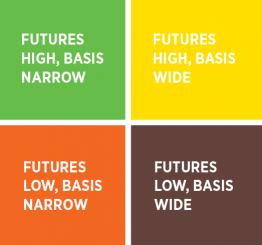Marketing strategy starts here
 The two factors in a cash price are futures and basis. Futures price minus basis is the cash price. This article will review ‘futures’ and ‘basis’ then explain the four futures-basis situations and what to do in each.
The two factors in a cash price are futures and basis. Futures price minus basis is the cash price. This article will review ‘futures’ and ‘basis’ then explain the four futures-basis situations and what to do in each.
Futures
Canola futures are traded at the ICE Winnipeg Commodity Exchange. Good global interest in a particular futures market adds liquidity, which means futures prices move minute to minute and getting in and out of the market is fairly easy. The canola futures market is fairly liquid, making it a good pricing tool.
ICE has canola futures for five delivery months: January, March, May, July and November. If, for example, November 2016 futures prices are lower than March 2017 futures, the market is said to be “carrying”. Based on market knowledge on that day, the market thinks prices will go up. If November 2016 prices are higher than March 2017, the market is “inverted”, which indicates strong near-term demand.
On September 9 when this article was written, the WCE November 2016 canola futures opened at Cdn$462.40 per tonne, March 2017 opened at $475.00 and July 2017 opened at $485.10 – a “carrying” position. On that day, the market expected prices to go up through the marketing year.
As a reference, growers can also watch soybean and soy oil futures from Chicago Mercantile Exchange, two major influences on the canola futures prices.
Basis
Basis tends to vary based on local competition for grain, seasonal demand and transportation issues. Canola basis can range from $60 under (very wide) to $0 (very narrow), but these tend to be extremes driven by a jammed-full handling system (they can’t take any grain so the basis is really wide) or an immediate need to fill cars and get a train moving (they have a short burst of aggressive buying so the basis is really narrow, sometimes “over”). A basis range of $20 to $40 under is fairly typical.
Basis covers handling and rail freight fees and any other costs the handling facility incurs, as well as profit. Basis is location specific and can be negotiated. Negotiating basis can be an important step in successful marketing.
The FOUR situations
Growers will find themselves in one of these four basic marketing situations:
- Futures high, basis narrow. This is a market signal for growers to sell grain. If you like the price now but don’t want to deliver until March, you could sign a deferred delivery contract.
- Futures high, basis wide. Growers will want to take advantage of this high futures price, but the wide basis says that selling today on the cash market is not ideal. In that case, growers can sell futures, taking advantage of the high price, while holding on to their grain. A simpler tool for those not interested in selling futures is to sign a futures first contract with an elevator and wait for basis to narrow.
- Futures low, basis narrow. If futures market signals suggest that prices are likely to stay low, growers could take advantage of the narrow basis and sell on the cash market. If they sell but are worried that prices could rally, they could offset that sale by buying futures for an equivalent amount to their sale and transfer the price risk from the grain bin to paper. Or they could inquire about a price later contract that would allow them to deliver grain, receive partial payment and choose a final transaction price at a later date within a set time frame – say 90 days.
- Futures low, basis wide. This is a market signal to store grain and wait, especially if there is carry in the futures market. If futures are low and basis is wide, the market is over supplied. Deferred basis contracts could be a useful tool here to get some grain moving in a less-than-ideal market. With this contract, you lock in the basis and secure space at the elevator, but the future component is still open.
Stan Jeeves often uses this website for futures quotes and charts:
futures.tradingcharts.com
Alberta Canola has futures and cash prices on its website at dashboard.albertacanola.com
Marketing information is also available on MCGA’s site at canolagrowers.com and SaskCanola’s site at saskcanola.com




